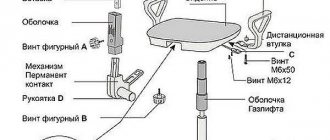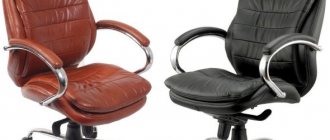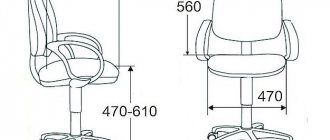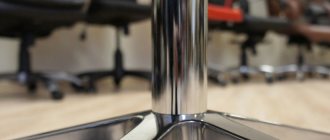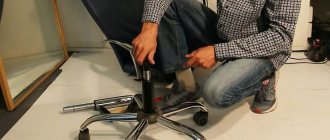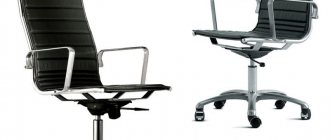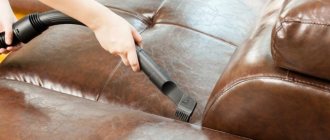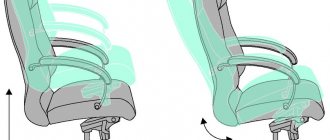Working at the computer: adjusting the office chair
For anyone whose work or study requires the use of a computer, it is important to have a comfortable chair that is maximally adapted to the individual physiological characteristics of the human body. Medicine has proven that incorrect, long-term stay in an office chair that is not adjusted to the parameters of a particular person leads to back pain, as well as to more serious consequences such as problems with intervertebral discs, spinal ligament sprains, etc. All this can be avoided learning how to correctly select and adjust an office chair.
Computer chair – the rule of choice
Knowing the basic criteria for choosing office chairs, you can provide yourself with a comfortable and safe workplace, where you can spend a long time without back fatigue and damage to your health.
- Choosing a chair that suits your body size. All computer chairs can be divided into two categories – for adults and children. Most seats purchased according to a person's age are suitable for ninety percent of people due to the multi-function adjustment available.
- The ability to change the parameters of the chair in a sitting position - adjusting the office chair to the characteristics of your own body will be much more convenient in this way.
- The ability to adjust the seat height is a fairly important criterion when choosing an office chair. The same applies to adjusting the backrest angle. Adjust them so that the position of your body is perfectly correct and work without pain and fatigue.
- Choose a chair where the front of the seat is slightly curved down. This will ensure sitting comfort by ensuring that the back of your thighs and the inside of your knees are in a comfortable position.
- Give preference to chairs whose upholstery is made of soft, breathable and non-slip fabric. Thus, you will provide yourself with comfortable sitting, both in summer and winter.
- Pay attention to the crosspiece of the computer chair - it must be stable to ensure balance. For greater ease of use of the chair, it is very important that the cross is equipped with wheels. When purchasing, you should check their working condition.
- It is worth giving preference to a chair with adjustable armrests. To ensure that arm movements are not limited, the height of the armrests must fully correspond to the size of the arms.
What parameters can be adjusted?
To adjust your office chair, you should adjust or adjust the following characteristics:
- Computer Chair Height – Moves the seat down/up to accommodate different leg lengths.
- The amount of backrest tilt allows you to ensure the most comfortable position of the seated back.
- Adjusting the swing mechanism – allows you to adjust the chair to the weight of a specific person.
- Adjusting the armrests on the chair (height, angle, distance between them).
Computer chair height adjustment lever
To determine the optimal location of a person sitting in an office chair, you should be guided by 3 principles:
- The center of the PC monitor should be at eye level.
- The sitter should feel good support for the curve of the lower back.
- The gap from the back of the shin to the front edge of the seat should be no more than 5 cm. To check, just stick your fist between them and, focusing on the result, move the chair forward or backward.
Gaming computer chair
How to adjust a chair
Proper adjustment of a computer office chair is a rather important point in organizing the workplace. After all, it is necessary to ensure not only a comfortable position for the user, but also to prevent as much as possible such unpleasant moments as pain and fatigue in the back.
All modern models of office chairs, both pneumatic and non-pneumatic, can easily change the position of different parts of their structure using special adjusting bolts and levers.
Customizing a chair to a person’s individual parameters consists of several stages.
Adjusting the seat height of a computer chair in accordance with the height of the workplace and your own height
Criteria to determine the optimal height of an office chair:
- the ideal seat height position can be determined in a standing position - the highest point of the seat should be below the knee;
- in a sitting position, you should sit at a comfortable distance from the table, put your hands on it and straighten your back so that your shoulders are parallel to your spine, and the angle of your bent arm should be ninety degrees. If your palms are below your elbows, this means that the seat of the chair is low for you;
- determine the correct level of your legs relative to the seat. To do this, place your feet parallel to the floor - the distance between the front of the seat and the thigh near the knee should be about 1.5-2 cm. If the distance is greater, then you need to raise the chair. If the finger is difficult to fit or does not fit at all between the seat and the thigh, this means that you should raise your legs. To do this, adjust the seat, and if this is not possible, use a special stand.
You can adjust the height of the chair upward as follows: stand up slightly and lift the lever located under the seat. When the desired height is reached, release it.
The seat height can be adjusted downwards without getting up from the chair - just pull the lever. When the chair lowers to the desired height under the weight of your body, release the lever.
Chair seat depth
This parameter is quite important, as it allows a person not to slouch while sitting in a chair, and also helps to minimize the load on the back, which, in turn, prevents various injuries.
To determine the correct depth of the chair, you need to sit down with your back straight and your feet on the floor. Then measure the distance from the front edge of the seat to the back of the shin. The ideal width of the space is about five centimeters. If the distance is less, this means that the chair is too deep and the backrest should be moved forward. If the width is more than 5 cm, then it needs to be moved back.
How to adjust the seat depth? In most cases, this can be done using a special lever. If this is not possible, use special backrests or orthopedic pillows.
Backrest tilt adjustment
It is no less important than the depth of the seat. The angle of inclination should be such that it can support your back when you sit in your favorite position.
There is an adjustment screw on the back of the backrest that will help you adjust the angle of inclination to the value you need. To do this, unscrew the screw and, leaning forward or backward, determine the most comfortable position for yourself. Once your selection is made, secure the screw.
Adjusting the armrests
Place your hands on the tabletop or keyboard so that the angle at the elbow joint is ninety degrees. In this position, your elbows should lightly touch the top of the armrests, moving freely along it from one side to the other. When they lie completely on the armrests, this limits movement and quickly leads to fatigue, since the hands feel the additional load.
You can choose a computer chair for long and productive work at the computer on the website https://www.qpstol.ru/.
Adjust the armrests using a screwdriver or screw. If lowering the armrests is not possible, it is better to remove them altogether. This way you will protect yourself from unwanted pain in your fingers and shoulders.
How to do it yourself
To adjust the parameters of the chair, you should carefully study its structure. Some models do not provide for certain regulatory mechanisms. And without them, it is simply impossible to set the backrest to a certain angle, the seat to a certain height, and the armrests to do both.
The delivery package of the furniture product should include instructions that will help you adjust it to your needs. However, you can also use general recommendations. First you need to decide on the height of the workplace and the depth of the chair. After this, you can begin adjusting the backrest. When everything is ready, all that remains is to adjust the angle and level of the armrests.
Height change
To change the height of the workplace, you need to use the lever, which is usually located under the seat on the left side. You should sit in an office chair and pull the handle up. In this way, the furniture is lowered to the required level. Next, you need to place your palms on the tabletop, and if it suddenly turns out that they are higher than your elbows, then the position of the chair needs to be adjusted again. To do this, stand up a little and pull the handle again: without any weight load, the seat will instantly rise.
Some models of chairs may have a rotary control instead of a lever, which must be turned to adjust the appropriate seat height.
If the user cannot figure out how to lower or raise his computer chair or office chair, and he is unable to perform the necessary actions, the problem may be as follows:
- This is not a normal, but a pneumonic model. To raise the chair, or vice versa, to lower it, the lever must be swung (pressed several times).
- The design has two regulators, not one. Each is responsible for a specific mechanism (raising or lowering). In this case, it is recommended to carefully study the instructions before making adjustments.
- The rotating arm only turns in one direction. If, when adjusting the seat height, the chair only rises, you must continue to rotate the handle. After a few turns it will start to go down.
In some cases, the problem may be a breakdown of the structure. For example, if the height of a chair changes only under the weight of a person (lowers when he sits down and rises when he gets up), the cause of this phenomenon is a malfunction of the gas cartridge. It will need to be replaced. If the lever of a new computer chair does not have the desired effect (when you press it), it may have been damaged during transportation. It needs to be inspected and adjusted using pliers.
Backrest tilt
If there is a screw on the back of the chair, it will allow you to change the tilt of the backrest. The adjuster should be loosened by turning it slightly counterclockwise, and then you should sit down and lean back and forth until the most suitable position is selected. After this, the angle of inclination should be fixed by twisting in the opposite direction.
Not all office chairs are equipped with screws for adjusting the backrest angle; budget furniture models do not have this function.
Armrest tilt
The armrest adjustment mechanism is usually located on the left side. To adjust the height, you will need to hold down the button, then raise the armrests to the desired level, and then release the held button.
DIY office chair repair: instructions with video
A modern office chair is a functional and comfortable piece of furniture, equipped with a rather complex mechanism that sooner or later fails. In such a situation, there are three options for the development of events: purchase a new one, take it to a specialized workshop, or repair the office chair yourself.
As practice has shown, it is quite possible to carry out such work on your own. The only thing that is required from the master is strict adherence to the sequence of actions and implementation of the instructions that will be given in this publication.
Types of office chairs
Today, there are three types of chairs on the office furniture market:
- For a manager This piece of furniture usually has maximum capabilities: a five-beam steel cross; synchronization mechanism (a device that forces the seat and backrest to repeat the movements of the owner); mechanisms for adjusting backrest resistance, seat depth, negative tilt, etc.
- For staff , furniture of this type has more modest characteristics and functionality. Most varieties are lightweight (ensuring high mobility) and are equipped with mechanisms for adjusting seat height, armrests, and back angle.
- For visitors, Office chairs of this modification are simply beautiful, stable and comfortable furniture, devoid of any functionality. Often they do not even have a rotation mechanism and are produced on four legs, instead of one supporting leg with a cross on wheels.
How to adjust an office chair
The main models of modern office furniture have devices and levers for easily changing the parameters of the chair. There are several stages of adjusting products to the individual parameters of the owner:
- Changing the seat depth.
- Backrest tilt adjustment.
- Changing the position of the armrests.
- Seat height adjustment.
REFERENCE! Comfort in an office product depends not only on the settings; the main cause of discomfort during use is incorrect fit. It is important to try to follow known standards: the eyes are at the level of the monitor, the elbows and knees are at 90-degree angles.
Product height adjustment
If, after changing your seating position, the feeling of back pain persists, it is worth adjusting the position of the chair. Algorithm for setting parameters:
- Find the adjustment lever. Modern chairs are provided with this lever, which is located directly under the seat. Do not confuse it with the tilt lever; it is attached to the base. If the lever is not found, you should look for the regulator in the form of a wheel under the seat. Study the instructions carefully if no adjustment devices are found.
- Raise or lower the lever. While sitting in the chair, pull the lever up to raise or lower until you achieve the ideal position. Stand near the product, if the edges of the seat are located at knee level, then you have determined the height you need. Some models involve “pumping” the lever up and down with even movements. To change the height of old products, large loads should be applied to the seat.
- Create comfortable conditions. When the height parameters are adjusted, it is worth achieving absolute comfort when working. Buy a footrest if the distance to the floor is too far for you, and adjust the height of the armrests so that they are level with your desk.
IMPORTANT! Doctors recommend changing your body position in the chair every 10–20 minutes. This will help avoid health problems and completely eliminate back discomfort.
Design features
Despite the variability of designs and functional content, almost all chairs consist of one set of elements:
- Five-beam cross (base). This part is made of metal or plastic. The first option is better quality and more expensive
- Rollers . Just like the crosspiece, the wheels can be made of metal or plastic. However, the mount and internal hinge of any roller are metal
- Pneumatic cartridge (gas lift). The part serves as the leg of the chair and is responsible for its “elasticity”
- The swing mechanism contributes to the axial deflection of the chair and its fixation in one position. On expensive models, a mechanism with an offset axis is installed, ensuring the smoothest swing possible.
- Piastra . This element is a metal platform with a lever. Serves to change the height of the seat relative to the cross
- Permanent contact is an element that connects the backrest to the seat and is responsible for changes in its position
Most office chair models have armrests. In cheap models, these elements are made of plastic; in more expensive ones - made of anodized or stainless steel.
Office chair mechanisms
Chair mechanisms
The price of an office chair depends both on its external qualities and on its technical parameters. The upholstery of the chair greatly influences the price; it can be made of different materials, ranging from simple fabric to high-quality leather. But still, most of the cost of the chair is its mechanisms. Let's talk about them.
Different companies make different mechanisms for their chairs, but they are all similar and some are unified to international standards. Let's start with the simplest one, which is used for inexpensive chairs.
1. Piastra
The unit connecting the gas lift rod to the base of the operator's chair seat. The piastra is equipped with a gas lift adjustment lever. In the production of piastres, welding of the gas-lift fastening coupling along the entire contour and an iron sheet of increased thickness are used. Attached to an office chair using four bolts. There are also holes on the pistre for attaching the back of the chair, and various mechanisms can be used for connection:
Spring-screw mechanism for constant back support - there is a spring under the plastic “knob”. And when twisted, it contracts, imparting rigidity to the tilt of the back, or vice versa, making the tilt easier.
2. TOP GAN swing mechanism (DMS)
Functions: adjusts the chair height and allows the office chair to swing. The mechanism allows the chair to be fixed in a vertical position while swinging; some more expensive models allow it to be fixed in the maximum reclined position, mainly on executive chairs.
The mechanism that locks the chair in the working position has three adjustments.
- The chair is adjustable up and down using a lever that acts on the gas lift (on some models of chairs, instead of a lever, a “button” is used to adjust the height)
- The same lever, when adjusted to the right or left, allows you to “turn on the swing mechanism” or fix the chair in the working position (i.e. with a vertical backrest). In some models, this function is performed by an additional lever.
- The spring allows you to adjust the rigidity of the swing according to the weight of the person sitting.
This mechanism can be divided into two types.
- Central-axis - the swing axis is located directly in the center of the seat; when the chair is fully tilted, the sitting person’s legs come off the floor, which is not a positive point. This mechanism is mainly used on inexpensive executive chairs and staff chairs.
- A mechanism with an offset center - the swing axis of the chair is shifted to the front of the seat, even with the chair fully tilted, the legs of the seated person do not come off the floor, thereby not interrupting the blood flow to the legs. This mechanism is mainly used in executive chairs and much less often in employee chairs.
Common breakdowns
As noted above, an office chair is a rather complex device and any of its structural elements can fail.
Damage to the cross
The problem with this element may be destruction at the junction of the beams. The material from which the cross is made is important here.
As a rule, the base is a hollow structure into which a polypropylene pipe of suitable size and cross-section can be inserted. It, in turn, must be rigidly fixed to the base and the damaged beam.
Plastic parts cannot be spliced using glue or a soldering iron due to the large loads on the paws. There is no point in restoring the integrity of this element. The best option would be to completely replace the damaged structure with a glass-filled polyamide base.
In order to dismantle the crosspiece of an office chair, you need:
- Remove the rollers . As a rule, they do not have a rigid fixation and are quite simply removed from the mounting sockets. To illustrate the process, it is recommended to watch the video:
Note! In case of critical damage or destruction, it is impossible to knock the gas elevator out of the base. In this case, you should remove the working cylinder with the seal and bearing from the “glass”.
The process technology and dismantling device are shown in the video:
Destruction of the swing mechanism
If the chair does not hold the “horizon”, then the problem is most likely in the destruction of the swing mechanism.
Fastening to the seat is done with four screws using a shaped screwdriver. The element is dismantled as follows:
- The bolts that secure the rocking mechanism from the seat are unscrewed
- The gas lift is knocked out of the device mount.
This element is made of metal.
You can independently solve the problem of a collapsed device by completely replacing it (recommended) or using a welding machine.
It should be noted that most chairs originating from the Middle Kingdom are not suitable for domestic spare parts. This concerns, first of all, the swing mechanisms (size discrepancy).
- Chinese mechanisms: 200 x 200 mm.
- Domestic: 200 x 150 mm.
In order not to re-drill holes when replacing an element, we suggest using adapter plates. How it looks assembled can be seen in the figure below.
Air chuck failure
The pneumatic cartridge of the chair is a two-chamber structure filled with air. When you press the adjustment lever, the valve stops the flow of air between the chambers.
If, when pressing on the valve, the gas lift rod does not extend, it means that the integrity of the piston, seal, etc. is compromised.
It is important to know! The gas lift cannot be disassembled . If damaged, a complete replacement of the element is required
The dismantling process is described above. To clarify the process, watch the video about replacing the gas cartridge on office chairs:
A fairly common cause of gas lift failure is the bending of the adjustment lever, which does not allow pressing on the cartridge valve. In this case, the repair can be easily carried out independently: you need to bend the lever to its original state.
Passive office chair adjustment
Passive settings are achieved without additional mechanisms. This type of adjustment includes adjusting the armrests. Some models adjust the location of the armrests in the direction of horizontal reach or height.
There is also the possibility of sealing the seat and back to ensure a comfortable fit and even distribution of the load on the chair. Another mode is a compacted bend on the upper edge of the chair. It relieves compression of the lower extremities in the area of the kneecaps.
It is recommended to adjust the armrest so that the bend in the elbow area is at least 90°.
Active seat adjustment
Active adjustment of an office chair is carried out by adjusting special mechanisms. Let's take a closer look at each mechanism.
- Standard. This option provides the ability to adjust the chair to suit different heights.
- Rocking. Provides easy rocking, provides the ability to change the level of deflection of the seat and backrest, taking into account the user’s weight. Additionally, it will be possible to fix the back and seat in a comfortable position.
- Depth level. Responsible for changing the seat depth. This mechanism is necessary for employees with large muscle mass or excess weight.
- Permanent contact. Responsible for the ability to change the location of the backrest, its height, as well as the depth of the seat. The mechanism ensures tight contact with the back, regardless of human movements and activity.
- "Freelock" This mechanism is responsible for modifying the angle of deflection of the backrest using a lever and installing it in the set position. The number of positions is not limited.
- Free style. Ensures the achievement of continuous swing, while regulating the force and power of deflection. The chair is securely fixed to the back and holds the spine well.
- Multiblock. Guarantees easy swinging by adjusting the force of deflection. There are 4 modes. The mechanism is equipped with an “anti-shock”.
- Synchronicity in deviation. Responsible for uniform rocking, changing the inclined angle in parallel with adjusting the location of the seat. Thanks to the given option, the adjustment of the deflection force is guaranteed, which depends on the weight of the subject.
How to set up the swing mechanism
The first thing to do is decide on the rigidity of the swing. This parameter depends on the weight of the person sitting. If the computer chair was bought for a child, then the spring needs to be loosened. If we are talking about a chair for an adult weighing 90 kilograms or more, then it needs to be tightened to the maximum.
Algorithm for setting the swing mechanism:
- Find the spring responsible for the swing of the structure. As a rule, it is located in the front of the chair under a plastic cap.
- To adjust, turn the handle clockwise or counterclockwise, periodically checking the optimal stiffness for the person sitting.
If the spring is twisted to the maximum, there is no need to apply force to turn it further. Otherwise, the thread on the bolt located in the center may be stripped, and the swing mechanism will be faulty.
Some chairs have a different structure. Instead of a spring and a rounded handle, they are equipped with two levers (right and left). The first of them is responsible for raising and lowering the seat. The second is for the rigidity of the swing.
Selection of mechanism depending on operating time
The choice of office chair and its adjustment mechanism is chosen according to the time you plan to spend at work or hobbies.
If you plan to spend no more than 2 hours working, choose a chair with adjustable seat height.
If you plan to spend no more than 4 hours in the chair, give preference to models with adjustable seat height and backrest angle. Options that allow you to further adjust the seat depth and back angle are welcome: “free style”, “permanent contact”, and for the manager - “swing mechanism”.
Those who work longer than 4-5 hours should pay attention to the presence of a free swing function and adjustable backrest tilt force.
The angle of the backrest should be 90° - this position will be the balance between working and relaxation. In executive chairs, the angle of inclination will be greater, but within reason, because it is impossible to work in a semi-lying position.
Keep in mind that the cost of an office chair depends on the number of possible adjustments. The more complicated the design, the more the reliability and strength of the model decreases.
To determine which chair setting is appropriate, place your feet completely on the floor so that your legs are bent at a 90° angle.
Adjusting your office chair is an important aspect of working productively in front of a computer at your desk. To find a wide range of office chairs and choose a comfortable one, visit stores from the TAM.BY catalog.
If you notice an error in the text of the news, please highlight it and press Ctrl+Enter
Armchair SU-BK-10
Red Red Gray gray Dark gray Blue Blue Black Black
Add to cart RUB 9,105 – RUB 9,920
The gas shock absorber is used to adjust the seat height.
The seated thigh should be on the seat, and pressure should be avoided on the back of the knee joint.
Choose the front edge of the seat to be softer and curved.
If an employee has to access different objects on or around the desk, then the office chair should be equipped with wheels and rotate.
Armrests
Office chairs do not need armrests. In some cases, they may even be unnecessary - for example, the armrests may rest against the table or keyboard stand (if the chair is not height adjustable).
CH-1300/GRAY Gray JP-15-1
CH-1300/BLUE Blue JP-15-5
CH-1300/CHERRY Bordeaux JP-15-6
So first decide whether you use armrests, and if so, here are some recommendations:
- armrests should be at the level of the keyboard stand or 3 cm above it
- The height of the armrests should be such that the elbows can rest on them, but do not pull the shoulders up. Therefore, their height adjustment is important.
- Changing the depth of the armrests is very useful - it allows you to change the distance between the front edge of the armrests and the edge of the tabletop.
Back
The backrest tilt adjustment mechanism must firmly fix the backrest, be of high quality and durable.
The main requirement for a rigidly fixed backrest is to check how well it is attached to the seat.
What is the optimal backrest position?
The optimal angle of backrest tilt is from 5 to 20 degrees from the vertical plane.
In this case, the person does not have to lean forward, leaning on the table, and he does not slide down the seat.
The back should have a cushion under the lower back.
The optimal back height is to the edge of the shoulders.
In the case when the back only reaches the level of the lower edge of the shoulder blades, the muscles of the back and thoracic region are in tension.
Product height
In rare cases, the employee may be able to adjust the height of the desk. Most often in offices this is not possible, so you have to change the height of the chair. It is necessary to adjust it so that the seat is located just below the knee. In a sitting position, the employee's elbows placed on the table should have a right angle. This is the optimal position for long-term work.
To properly set up a computer chair, you need to sit at the table as close as possible and place your hands on its surface. If your elbows are at a 90 degree angle, then everything is fine. Otherwise, you need to raise or lower the seat. As a rule, the lever for controlling the chair is located on the left under the seat.
To lower the seat, you don't even need to sit up - just pull the lever. To raise the seat, you need to stand up. Then the chair will begin to rise. When it takes the desired position, it is worth checking how correctly the structure is adjusted.
Leg position
You can determine that the computer chair is positioned correctly by the position of the legs. When seated correctly, there will be a finger-thick gap between the thigh and the seat. If the gap is smaller, this means that the chair needs to be made lower. A good footrest will also help in this situation. The computer chair can be positioned normally, but if you are tall, there will be an increased gap between the seat and the thigh. It is better to raise the chair to eliminate the gap.
You can check the depth of the chair by trying to insert your fist between the back of your shin and the adjusted seat. When seated correctly, the fist moves freely. If the landing is too deep, then the fist will pass through with difficulty. In this case, you need to customize the product again. Some models of chairs have a lever on the right that allows you to adjust the seating depth.
Sometimes too much distance is created between the shin and the edge. This indicates that the backrest is in the wrong position. You can adjust its position using the lever. If the seating problem cannot be solved, you will have to use special pillows and pads for the chair. It is enough to purchase an orthopedic pillow to prevent lower back pain and other problems.
All adjustments of the chair with the TopGan rocking mechanism
— there is an adjustment for free swing, — fixation of the backrest in the working position, — adjustment of the force of deflection, adjusts to the weight of the seated person.
Below we will look at all the possibilities of this mechanism.
1. First adjustment, height. You can change the height of the seat by turning the lever (see Fig. 1), which, in turn, acts on the gas lift. The seat can be raised or lowered to suit the height of the user.
2. The second adjustment is to fix the chair in a working, vertical position , stopping the backrest from swinging. This can be done using the same lever (Figure 1), but this time we turn the handle to the right or left. When turning, the lever enters a special round hole to the left of the mechanism and locks the backrest in the working position, you sit straight and the chair does not lean back.
3. Adjusting the chair to your weight . In the front part of the mechanism there is a special spring hidden by a cap, which regulates the rigidity of the chair back swing. If you tighten the spring strongly, then a person with a lot of weight can sit comfortably on the chair. If the spring is weakened, then the swing becomes easy, comfortable for a person with little weight. This mode is adjusted by turning the knob clockwise or counterclockwise. Attention! You should not apply too much force; if the spring is completely fixed, you can break the thread on the bolt, which is located in the center.
TOP-GAN swing mechanism, how to adjust, video:
How to adjust the backrest
The height of the back of the chair provides back support and lumbar deflection.
To adjust its position, you first need to sit down correctly. The previous instructions should already be completed. Changing the position of the backrest of an office chair without adjusting the height is pointless - the fit will still not be correct. Having taken the correct position in the chair, you need to adjust the backrest so that it supports your back and does not create an excessive tilt forward or backward. The position is adjusted as follows:
you need to use the screw at the back of the chair to raise the backrest to the limit;
then you need to sit in a chair and change the position of the screw until the backrest takes the correct position;
- if the product does not have an adjusting screw, you will have to use orthopedic products.
In addition to the height, you need to set the correct backrest angle. When the back of the office chair is at the desired height, you can adjust the tilt using another screw. The backrest angle is determined by your favorite position. When sitting in this position, you should feel that the chair is supporting you. The tilt adjustment feature is not available on all models.
Chair armrests
Once the chair height and backrest position are adjusted, you can adjust the position of the armrests. They should barely touch the elbows when the user operates the keyboard. If the armrests are in the way, there will be a problem with seating. Armrests that are too high lead to problems with the shoulder joints.
The position of the armrests can be adjusted with screws or a screwdriver. In some models, the height is not adjustable at all. If you can't adjust the position of the armrests properly, remove them altogether - they can cause joint problems if they are in the wrong position.
All adjustments of the chair with the TopGan rocking mechanism
— there is an adjustment for free swing, — fixation of the backrest in the working position, — adjustment of the force of deflection, adjusts to the weight of the seated person.
Below we will look at all the possibilities of this mechanism.
1. First adjustment, height. You can change the height of the seat by turning the lever (see Fig. 1), which, in turn, acts on the gas lift. The seat can be raised or lowered to suit the height of the user.
2. The second adjustment is to fix the chair in a working, vertical position , stopping the backrest from swinging. This can be done using the same lever (Figure 1), but this time we turn the handle to the right or left. When turning, the lever enters a special round hole to the left of the mechanism and locks the backrest in the working position, you sit straight and the chair does not lean back.
3. Adjusting the chair to your weight . In the front part of the mechanism there is a special spring hidden by a cap, which regulates the rigidity of the chair back swing. If you tighten the spring strongly, then a person with a lot of weight can sit comfortably on the chair. If the spring is weakened, then the swing becomes easy, comfortable for a person with little weight. This mode is adjusted by turning the knob clockwise or counterclockwise. Attention! You should not apply too much force; if the spring is completely fixed, you can break the thread on the bolt, which is located in the center.
Correct fit
If you set up your computer chair correctly, the monitor will be directly at your eye level.
In some cases, it is worth choosing a different chair. It is recommended to pay attention to models in which the back and armrests are adjustable with screws. The structure must have an anatomical shape. There should be a curve at the front of the seat.
The back should also have an anatomical curve that supports the lower back. Stability while sitting will be ensured by a reliable five-pointed stand. This design is convenient for adults and children.
